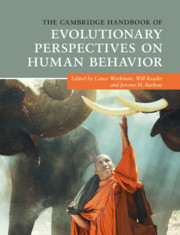Book contents
- The Cambridge Handbook of Evolutionary Perspectives on Human Behavior
- The Cambridge Handbook of Evolutionary Perspectives on Human Behavior
- Copyright page
- Dedication
- Contents
- Figures
- Tables
- Contributors
- Preface
- Acknowledgments
- Part I The Comparative Approach
- Part II Sociocultural Anthropology and Evolution
- Part III Evolution and Neuroscience
- Part IV Group Living
- Part V Evolution and Cognition
- Part VI Evolution and Development
- Part VII Sexual Selection and Human Sex Differences
- 26 Survival, Selection, and Sex Differences in Fear
- 27 The Enigmatic Urge
- 28 Are Humans Peacocks or Robins?
- 29 Human Mate Selection
- 30 Kin Selection and the Evolution of Male Androphilia
- 31 Evolutionary Psychology
- Part VIII Abnormal Behavior and Evolutionary Psychopathology
- Part IX Applying Evolutionary Principles
- Part X Evolution and the Media
- Index
- References
28 - Are Humans Peacocks or Robins?
from Part VII - Sexual Selection and Human Sex Differences
Published online by Cambridge University Press: 02 March 2020
- The Cambridge Handbook of Evolutionary Perspectives on Human Behavior
- The Cambridge Handbook of Evolutionary Perspectives on Human Behavior
- Copyright page
- Dedication
- Contents
- Figures
- Tables
- Contributors
- Preface
- Acknowledgments
- Part I The Comparative Approach
- Part II Sociocultural Anthropology and Evolution
- Part III Evolution and Neuroscience
- Part IV Group Living
- Part V Evolution and Cognition
- Part VI Evolution and Development
- Part VII Sexual Selection and Human Sex Differences
- 26 Survival, Selection, and Sex Differences in Fear
- 27 The Enigmatic Urge
- 28 Are Humans Peacocks or Robins?
- 29 Human Mate Selection
- 30 Kin Selection and the Evolution of Male Androphilia
- 31 Evolutionary Psychology
- Part VIII Abnormal Behavior and Evolutionary Psychopathology
- Part IX Applying Evolutionary Principles
- Part X Evolution and the Media
- Index
- References
Summary
Sociobiological approaches have made great inroads into psychological science over the last few decades. This has not come without a fight. One of the main fronts on which the battle has been fought is the origins of human sex differences. Evolutionary psychologists have made a strong case that many basic sex differences in our species have an evolutionary origin; the case is now so strong, in fact, that it seems unreasonable to deny a significant evolutionary contribution. A question mark remains, however, over the relative magnitude of the evolved differences. Are we highly dimorphic, polygynous animals like peacocks? Or are we relatively monomorphic, pair-bonding animals like robins? In this chapter, I argue that we are closer to the latter than the former – a fact that makes us somewhat anomalous among the animals. In many species, the males alone compete for mates and the females alone choose from among the males on offer.
- Type
- Chapter
- Information
- Publisher: Cambridge University PressPrint publication year: 2020



